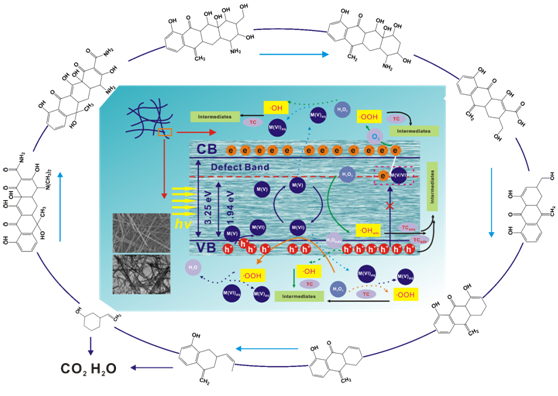The presence of antibiotics in aquatic environment has attracted global concern. Fenton system is one of the most popular methods to eliminate the antibiotics in aquatic environment. However, the existing Fenton system is limited due to the potential second pollution and narrow pH range (~3-5).
Recently Chinese scientists at Nanoscale (https://pubs.rsc.org/en/journals/journalissues/nr#!recentarticles&adv) reported that the bottlenecks for high strength tetracycline (TC) wastewater treatment at neutral condition were well tackled by one class of mixed-valence W/Mo containing oxides (WMoO-x) with tunable morphologies (<Morphology-tunable WMoO catalysts for the extremely efficient elimination of tetracycline: kinetics, mechanisms and intermediates>DOI: 10.1039/C8NR08162J).
In their work, triethanolamine was selected as a structure-directing agent to control the catalysts morphologies from ultrathin nanowires (UTNWs) to wires-tangled nanoballs (WTNBs). As a proof of concept, the most efficient catalyst in the batch samples, WMoO-1 UTNWs were employed as a model material for TC degradation, in which the coordinatively unsaturated metal atoms with oxygen defects served as the sites for TC chemisorptions and electron transfer. As a result, 91.75% of TC was degraded in 60 min for the initial TC concentration of 400 μM. Furthermore, liquid chromatography mass spectrometer (LC-MS) analysis confirmed that the TC could be degraded to the nontoxic by-products without benzene ring, and finally mineralized to CO2 and H2O. Inductively coupled plasma mass spectrometry (ICP-MS) and cycle experiments showed the good stability and reusability of WMoO-1 UTNWs during the Fenton-like system. The findings of this work provid fresh insights into design of nanoscale catalyst morphology and reaffirms the versatility of doping in tuning catalyst activity. It offers plugs for widening the range of the optimal pH values up to neutral conditions, and it is significant for the expansion of the heterogeneous Fenton-like family and its application in the field of water treatment.
The research team includes a major group led by Prof. LIU Jinhuai and Prof. KONG Lingtao from the Nano-Materials and Environmental Detection Laboratory of the Institute of Intelligent Machines(IIM) , Chinese Academy of Sciences (CAS). HUYi made major contributions to this work. This work was supported by the Natural Science Foundation of China (21277146, 61605221, 61273066, 11205204 and 61374017), the Key Technologies R & D Program Foundation of Anhui Province (1704a0802136), the Chinese Academy of Sciences Key Deployment Project (KFZD-SW-309), the Young Spark Project Foundation of CASHIPS (YZJJ201617), and the CASHIPS Director’s Fund (YZJJ201701).
Key Words: Fenton-like; Tetracycline; Morphology-tunable; Ultrathin nanowires;Mechanisms; Intermediates
Article link: https://pubs.rsc.org/en/content/articlelanding/2019/nr/c8nr08162j
Article title: Morphology-tunable WMoO nanowire catalysts for the extremely efficient elimination of tetracycline: kinetics, mechanisms and intermediates

Fig. 2 The schematic illustration of the mechanisms of TC degradation during the WMoO-1 UTNWs/H2O2 process
